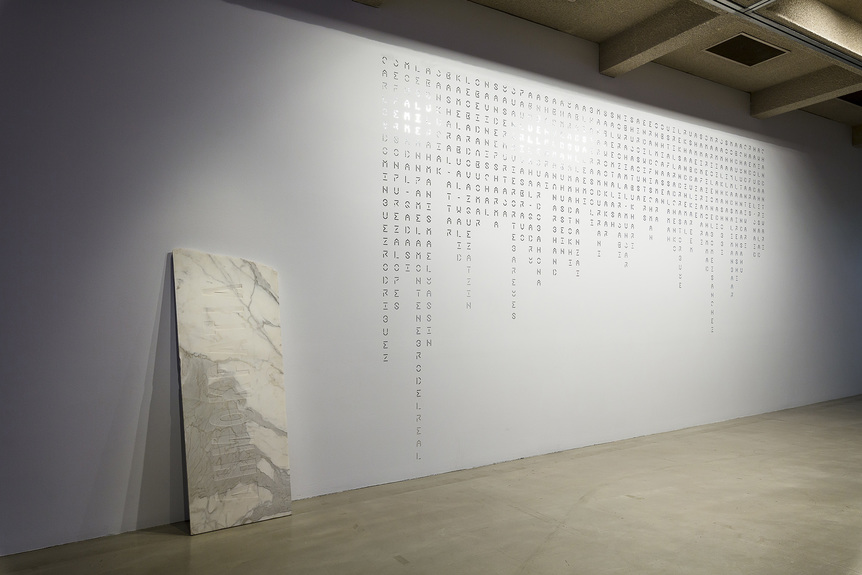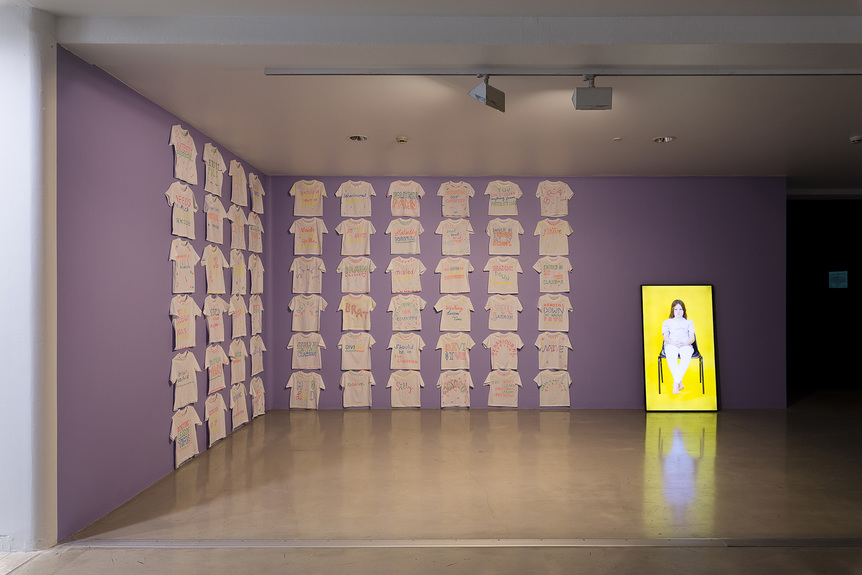-
From Current Issue
-
- Editor’s Letter Fire in the Heart
- Reviews I Gusti Ayu Kadek Murniasih
- Reviews 11th Seoul Mediacity Biennale: “One Escape at a Time”
- Dispatch Networked China
- One on One Monira Al Qadiri on Yukio Mishima
- Essays The rise of independent art spaces in pandemic-era Shanghai
- Features Tuan Andrew Nguyen
- Table of Contents
- Web Exclusives
- Archive
- Subscribe

R
E
V N
E
X
T
Installation view of ABDULLAH MI SYED’s (center, on runway) Fashion Statement, 2019, digital print on gloss paper and tape, 98 × 64 × 25 cm each; and (left and right) Capital Couture, 2019, handfolded banknotes, staple pins, dimensions variable, at “OK Democracy, We Need to Talk,” Campbelltown Arts Centre (CAC), Sydney, 2019. All images by Document Photography; courtesy CAC.
In 2018, the phrase “fair dinkum” was used by Australian politicians in parliament 150 times, the most in any single year to date. It has been part of the Australian vernacular since the 19th century, as a positive description of anything fair, honest, good, or true. Abdullah MI Syed’s Fashion Statement (2019) displays the phrase printed onto one of several paper dresses, all lined up on a runway at Campbelltown Arts Centre (CAC). Drawing on the superficiality of fashion, Syed’s sartorial invocation of the term comments on the emptiness of contemporary Australian political discourse, gesturing at the ways in which capitalist democracies are literally and metaphorically intertwined with and fabricated on money, power, appearance, and labor.
Syed is one of ten artists included in CAC’s provocative group exhibition “OK Democracy, We Need to Talk,” which unpacked the flaws of the prevailing neoliberal democratic system through twelve newly commissioned works tackling the creation, modification and exploitation of images and rhetoric in constructing democracy and national character.
Democracy itself was presented as a fractured political framework, a critique encapsulated by Eugenia Raskopoulos’s In a word untitled #1 (2004), in which a marble slab inscribed with the word “Democracy” in Ancient Greek rests precariously against the wall, broken at one end. The sculpture is an apt metaphor for the skewed power relations that exist within the present neoliberal configuration of the system, also alluded to in Eugenia Lim’s sophisticated indictment of the gig economy, On Demand (2019). Here, five bicycles face a screen that only plays Lim’s video when somebody is cycling, drawing parallels between the physical exertion demanded of the gallery-goer by this set-up and the precarity, instability and exploitation of freelance labor. Lim further dissects the power dynamics between independent contractors and institutions in the video, which depicts testimonials by independent contractors for companies like Uber and Airtasker, as well as by artists and cultural workers.
The strength of the exhibition lay in its meta-commentary on the way galleries themselves are bound up with neoliberal values and politics, provoking questions on how art can negotiate and function within the capitalist system. Sarah Rodigari’s installation Composition for Eight Voices (Withdrawal) (2019) included five lithographs featuring lines of text such as “to speak of a career in art is to speak of it in relation to capital”; these observations, by interviewed artists, resonate through the space via a sound recording. Critiquing the inequalities inherent in the art world, Richard Bell’s video Embassy 2019: Venice. ART. IN. ACTION. (2018–19) documents his plan to gate-crash the 58th Venice Biennale after his proposal was rejected. The Indigenous artist’s Venice project involved wrapping a replica of the Australian Pavilion in chains and floating it down the Venetian lagoon on a barge, as well as pitching his tent installation, Embassy (2013– ), based on the Aboriginal Tent Embassy protest site in Canberra. Directly circumventing the official system of selection, Bell’s intervention exposes how certain voices and narratives are excluded from the art world.
While exhibitions centered on serious global problems risk the pitfall of seeming despondent in tone, “OK Democracy, We Need to Talk” also provided a much-needed inflection of hope and resilience. For example, Lara Thoms’s Blatantly Disrespectful (2019), an installation of small white cotton shirts playfully decorated with colorful puff paint, affirms the power of child activists. As a form of reclamation and subversive celebration, inscribed on the shirts are demeaning terms often levied against the youngsters, such as “brainwashed,” “naive,” and “political pawn.” Meanwhile, Kuba Dorabialski’s three-channel video In the Ordinary, Peaceful Course of Events, the Majority of the Population (2019) displayed the potential of democratic action through a fictional narrative of community activism. On one screen, a group of students are shown conversing with one another before they break the fourth wall, implicating the viewer into their call for action. On another screen, a marching band makes their way through a verdant green field, alluding to protest and grassroots resistance.
Ultimately, the exhibition underscored the power of art to resist existing hierarchies and open up truly democratic spaces for a polyphonic collective voice. In doing so, the exhibition galvanized critical conversations about democracy and the role of art within it.
“OK Democracy, We Need to Talk” is on view at Campbelltown Arts Centre, Sydney, until July 31, 2019.
To read more of ArtAsiaPacific’s articles, visit our Digital Library.

















